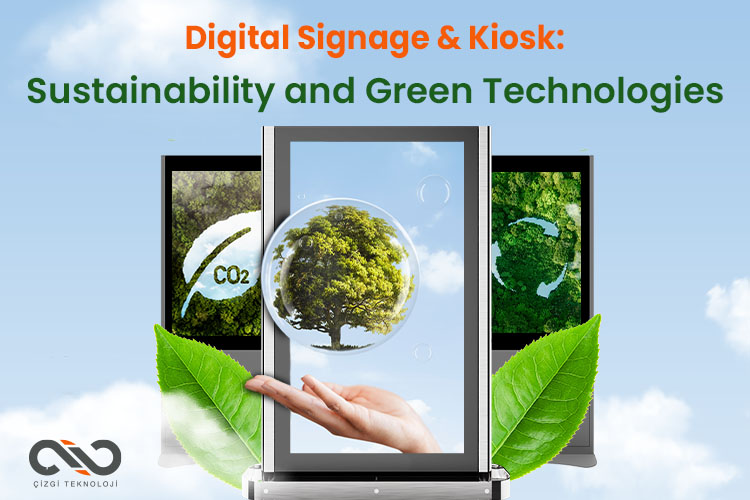Digital Communication and Green Technologies- The Sustainable Future of Digital Signage and Kiosks

The rapid development of technology has led to fundamental changes in the business world and consumer experiences. As part of these changes, digital signage and kiosk technologies have transformed how businesses communicate and deliver services. However, we should recognize the impact of these technologies not only on the way we do business but also on the environment. This article will examine how digital signage and kiosk technologies relate to sustainability and green technologies and how they contribute to the environment.
Energy Efficiency: Low Energy Consumption
Digital signage and kiosk technologies offer much lower energy consumption than traditional lighting and billboards. LED (Light Emitting Diode) technology, in particular, maximizes energy savings while providing high-brightness images. This helps businesses reduce energy costs and minimize their carbon footprint. In addition, automatic brightness settings optimize energy consumption according to need. The average digital signage display saves approximately 700 to 800 kilowatt-hours (kWh) of energy annually, equivalent to a family's monthly energy consumption. While the annual energy consumption of a conventional billboard averages 25,000 kWh, a digital signage display of the same size consumes approximately 10,000 kWh per year.
Less Paper Use and Paper Saving
Digital signage and kiosk technologies significantly reduce the use of paper. While traditional advertising and information methods require large quantities of paper and printed materials, digital signage and kiosks deliver content electronically. This minimizes the production and consuming brochures, posters and other paper-based materials. Therefore, protecting forests and avoiding energy-intensive paper production processes is essential.
Using digital signage and kiosk technologies saves an average of 300,000 to 400,000 tonnes of paper annually. The average business prevents the cutting down approximately 50,000 to 100,000 trees per year thanks to digital signage and kiosk technologies.
Content Management and Digital Advertising
Digital signage offers excellent advantages in terms of advertising and content management. These technologies can update advertisements instantly and deliver personalized messages to the target audience, avoiding producing and printing unnecessary advertising materials, thus saving paper and other resources. In addition, more targeted advertising means higher conversions and less resource use.
Remote Management and Energy Saving
Digital signage and kiosk systems offer remote management and energy-saving features. This allows content and software updates to be made without physical intervention. In addition, some kiosk systems can be powered by renewable energy sources, which means energy independence and a lower carbon footprint. Digital signage and kiosk technologies reduce an average of 1 million tonnes of carbon dioxide emissions annually, equivalent to the annual carbon emissions of many small vehicles. Businesses can achieve their sustainability goals more efficiently by reducing their carbon footprint through energy savings.
Awareness and Education
Digital signage and kiosk technologies can be used to support sustainability awareness and education campaigns. These technologies can raise environmental awareness in public spaces or business environments by displaying content emphasizing sustainability goals. For example, a kiosk in a shopping centre can share information promoting environmentally friendly products and recycling programmes.
Businesses and Sustainability
Digital signage and kiosk technologies help businesses strengthen their sustainability commitments. These technologies are based on sustainability principles such as energy saving, paper reduction and waste minimization. It encourages business practices that are in line with environmental sustainability goals. Furthermore, businesses contribute to the environment and communities by focusing on ecological sustainability goals. Reducing carbon footprint also means reducing operating costs.
Digital signage and kiosk technologies can prevent the generation of around 10 million tonnes of waste electronic products each year. This represents a significant portion of the electronic waste that should be diverted for recycling.
Commitment to Sustainability
For businesses, sustainability is no longer an option but a necessity. Taking steps to reduce carbon footprint, reduce waste, be more energy efficient and utilize resources more efficiently is the foundation for a more sustainable future in business. Digital signage and kiosk technologies are powerful tools to achieve these goals and help companies stay true to these commitments.
Conclusion Contributing to a Green Future
Digital signage and kiosk technologies have become critical to sustainability and green technologies. With low energy consumption, low paper usage, energy efficiency, waste management and content management, these technologies provide cost savings to businesses while reducing their environmental impact. They also promote sustainability in terms of advertising and content management. In the future, digital signage and kiosk technologies will continue to play an essential role in a greener and more sustainable world. Both businesses and the environment will benefit from using these technologies.
- Click here to view our Digital Signage and Kiosk product group.



 English
English
 TR
TR